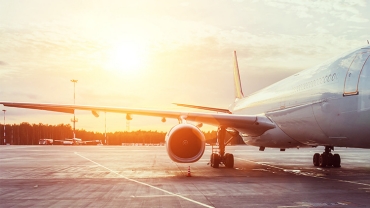
Last year’s Industry Outlook predictions were generally upbeat, so it is particularly gratifying to report that most of them came to pass. Perhaps the most important prediction was that the world would come to treat COVID as an endemic disease, rather than a pandemic, paving the way to the lifting of travel restrictions and the restoration of other personal freedoms. Until very recently, China was the only major hold-out for a zero-COVID policy (also another prediction), but the reversal of the country’s entire COVID policy, announced in early December, has eventually set China on a path to normality, albeit with some major concerns to overcome along the way.
The big event of 2022 that got missed in the predictions was, of course, Russia’s illegal invasion of Ukraine and the ensuing war, which has thrown the global economy into a recessionary tailspin, with interest rates, inflation and fuel prices rising well beyond anything experienced in recent memory and well above the elevated levels anticipated in the January 2022 predictions.
With most countries now welcoming overseas visitors once again without requiring Covid testing or quarantine, passenger demand has continued to accelerate, providing airlines with the unexpected challenge of having to scramble to return sufficient capacity to service in order to meet the demand. Most, if not all, readers will have noticed how much more expensive air fares have become – 23% higher on average compared to 2021, according to IATA. Whilst providing a financial boost for the airlines at this point in the Covid recovery process, this will have an impact on discretionary travel if sustained through the next peak leisure travel season.
Uncertainty has always made financiers and investors nervous and the continued conflict between Russia and Ukraine (or, as the Russian government chooses to define it, between Russia and the West), plus growing Chinese militarism in the sea and air around Taiwan, suggests that much of 2023 will continue to be overshadowed by uncertainty. As the airline industry looks forward to taking delivery of more than $100 billion of new aircraft this year, lessors, lenders, investors and rating agencies will need to look beyond the near-term to ensure that sufficient and affordable liquidity is available for deployment.
The global economy
Following the strong global recovery in 2021, when GDP rebounded by 6%, the IMF1 expects slower growth of 3.2% in 2022, impacted by the war in Ukraine and its wider ramifications. A number of advanced economies will fall into recession during 2023, which will push global GDP growth lower still, although still maintaining a V-shaped recovery, with a return to stronger growth expected in subsequent years.
Russia’s weaponization of oil, gas and Ukrainian wheat production contributed to a surge in inflation, reaching double digit levels in many countries and averaging 8.75% globally during 2022. Whilst inflation should have now peaked, it will remain at historically high levels for much of 2023, impacting airline input costs, trade flows and disposable incomes.
Faced with rapidly rising inflation, central banks around the world, led by the US Fed and the European Central Bank, have steadily raised interest rates over the course of 2022 to levels not seen since well before the Global Financial Crisis, with further rate increases still to come in 2023 until inflation is tamed. If, as is anticipated, inflation falls back into low single digits during the year, interest rates will be gradually wound back down, although not to the rock bottom levels of the past decade.
Although a strong US dollar is not an unusual phenomenon (the US Dollar’s trade-weighted index has remained above 100 since 2015), it hit a 20-year high in 2022, spurred by the Fed’s determination to tackle inflation. The dollar is also traditionally a refuge in troubled times and also tends to gain strength when energy prices are high. The impact of this is felt most in emerging markets, through higher debt servicing costs and, for airlines reliant on local currency revenues, in higher fuel and asset ownership costs.
March and June 2022 saw the price of Brent crude oil hit the highest levels for more than a decade, spiking at more than $125 per barrel. By September, the price had fallen back below $100 and is currently trading in and around $80 a barrel. However, 2022 also saw step increases in the crack spread (the refining margin between crude oil and Jet-A1 aviation fuel) following Russia’s invasion of Ukraine, averaging 50% across the year. This, rather than the price of crude, has been putting pressure on airline economics and driving some of the fare increases in the market. Crack spreads tend to normalise as refining capacity is adjusted, with an expectation that spreads will subside again in 2023.
The airlines
The relaxation or removal of Covid-related travel restrictions across much of the globe generated a surge of advance bookings and passenger travel throughout 2022, with VFR and leisure travel showing particular strength across Europe and the Americas. Asia’s full potential has yet to be realised in this regard, as countries in the region have generally been slower to remove barriers and, for many, a heavy reliance on Chinese travellers has delayed their overall recovery rate.
Visiting Friends and Relatives was always expected to lead the recovery and this has proved to be the case, along with vacation travel, which has been the main component of intra-European and trans-Atlantic bookings. Long-haul business travel is picking up more slowly, with the return of some elements of that market expected to be down-sized as companies prioritise transaction-related and relationship-building travel over on-site internal meetings, conferences and other non-essential activities. These recovery patterns favour the low-cost business model over full service network operations and this has been evident in the pattern of airline network and fleet rebuilding to date.
Global passenger numbers rebounded in 2022 by more than 55% according to IATA, with RPKs up by almost 70% reflecting the return of international travel. Average passenger load factors came close to 80% over the year, reflecting the persistent capacity constraints that kept ASK expansion below 45%. These constraints were partly due to a lack of fleet capacity, combining continued delivery shortfalls on the part of the OEMs with a shortage of MRO and engine shop capacity to perform fleet re-activation work and deferred maintenance. In addition, labour shortages created problems for airlines and also airport operators, both having laid off large numbers of skilled employees during the pandemic that have proved difficult to replace in short order, resulting in the cancellation of large numbers of planned flights across North America and at some of Europe’s largest airports.
The level of parked or inactive fleets continued to decline in 2022, though perhaps more slowly than expected, with 19% of the passenger fleet inactive at the end of December compared to 22% a year earlier. Within the totals, however, there was considerable variation by aircraft category, ranging from 15% for the narrowbody fleet, to 21% for widebodies and 29% for regional aircraft. And whilst there were only small differences between the most popular narrowbody types, widebody inactivity showed greater variation, from 7% of 787s and 15% of A350s, to 27% of A330s and 45% of A380s.
Although the dedicated air cargo operators enjoyed another strong year in 2022, overall air freight volumes declined by 8% following a 22% rebound in 2021. Most “preighter” operations ended in 2022, with aircraft returning to full passenger service, leaving overall cargo load factors languishing around 50%.
The airline industry reduced its annual net losses below $7 billion in 2022, according to IATA, although North America was the only region where airlines made a net profit ($9.9bn), while Asian carriers lost $10bn, Europe $3.1bn and Latin America $2bn.
Total airline losses over the three years of Covid exceed $186 billion according to IATA, with the industry receiving over $220 billion in financial support from governments over the period. Some of the largest carriers are already paying down these bailout sums to remove restrictions that in many cases were preconditions of support. However, for the majority of the industry, a long period of balance sheet repair lies ahead, including network, fleet and financial restructuring.
Passenger demand is expected to return another very strong year of growth in 2023, with the re- opening of China to inbound and outbound travel creating a travel surge that will substantially offset the economic headwinds faced in other parts of the world. A 21% increase in RPKs this year, followed by 17% in 2024 will take global traffic above the 2019 level, bringing forward the recovery horizon by 12 months compared to earlier expectations.
IATA is therefore predicting a modest industry profit of $4.7bn in 2023, generating a very skinny and fragile margin, with Asia and Latin America remaining unprofitable and Europe barely breaking even, however, airline results in 2024 are likely to be much stronger.
The lessors
Lessors entered 2022 with the majority of their lease restructurings completed. As most airlines’ revenue streams are now back on track, delinquency levels for the revised lease obligations have been low through the year and lessor profitability has been largely restored.
The proportion of lessor AOGs has fallen from 11% at the end of 2021 to 8% currently and lessors have experienced strong demand for younger narrowbody aircraft as airlines respond to the demand surge. Lease rates consequently firmed significantly over the course of the year, supported by a reduced flow of new deliveries into the global fleet.
The lessor share of delivery financing is firmly established above the once-elusive 50% threshold, having averaged 53% throughout Covid, with estimated delivery funding of $70 billion provided in 2022. Lessors have also built a $150 billion backlog of direct orders with the OEMs, with an estimated 750 aircraft available for lease over the next three years when OEMs are essentially sold out.
A round of lessor M&A activity during the year has moved SMBC Aviation Capital up to the #2 ranking by delivered portfolio value, behind a seemingly unassailable Aercap. ALC takes the #3 position, with Avolon at #4. Carlyle’s acquisition of AMCK takes them to #12 in the rankings. The ten largest lessors account for 54% of total leased fleet value. Chinese lessors, nine of which are ranked in the top 20, are understood to be pivoting to increasingly use their platforms and balance sheets to support domestic airlines and OEMs, with several portfolios being offered for sale in recent months.
Nine months have passed since Russia’s unlawful appropriation of around 500 western airliners operated by Russian airlines on lease from foreign lessors, with over 200 of these having now been illegally re-registered in Russia. There has been minimal recovery of assets to date and a growing number of affected lessors have initiated legal actions against their insurers, suggesting an unsurprising dragging of feet and reluctance to pay out on claims that total at least $10 billion. The passage of time makes it increasingly likely that few, if any, of these aircraft, or indeed any of Russia’s owned Western aircraft, will be able to return to commercial operations with non-Russian carriers or operate in non-Russian airspace.
A recent proposal by the Russian authorities that their airlines should submit proposals to the legal owners of their aircraft to purchase them outright further complicates the situation.
Notwithstanding the inability of Western lessors to engage in any such agreements without obtaining a sanctions waiver, the offer prices are likely to fall well below book or market values and therefore unattractive to the majority of lessors and owners. However, insurers may argue that lack of engagement on the part of the lessors could be construed as a failure to take steps to mitigate their losses, thereby jeopardising their claims. This story still has a long way to run, but the Russian component of global airline and lessor was never large and, whilst remaining an unwelcome distraction, will not have a material impact on the industry outside of Russia.
The OEMs
Orders and deliveries both saw material increases over 2021, up by 40% and 20% respectively. However, only one part of last year’s split prediction was realised, with orders at their highest level since 2014. Deliveries remained well below pre-Covid levels, with OEMs stymied by supply chain issues and, in the case on Boeing, wider delivery issues for 737MAXs and 787s.
Airbus delivered 661 aircraft in 2022, short of its revised target of 700 and almost 100 shy of its original 750 number. 653 deliveries were commercial airliners, including over 500 A320neo family variants, and 87 widebody deliveries represent a 40% increase over 2021.
Boeing delivered 480 aircraft during the year, of which 451 were commercial airlines. These included 360 737MAX aircraft, of which approximately 160 were delivered from the accumulated backlog of previously built aircraft, plus some 200 new builds from a gradually ramping production line. 787 deliveries remained frozen by the FAA until August, when approval to re-start was given. An estimated 10 new build and 21 pre-built aircraft had been delivered by year-end.
The remaining backlog of almost 100 787s is expected to take two years to clear as Boeing has advised that the technical input required for prepare each aircraft for delivery exceeds the time required to build a new aircraft. The 787 delays meant that almost all of Boeing’s 2022 widebody deliveries were freighters, including the last 747 to be built, ending more than half a century of production for the type.
Other OEMs delivered around 130 commercial airliners during the year, leaving Airbus and Boeing with 90% of the market. Notable amongst the other OEMs was COMAC’s first C919 delivery, to China Eastern in December, following CAAC certification in September. Market penetration is predicted to remain low and mostly confined to Chinese operators and lessors, with COMAC guiding that they expect to reach only 25 deliveries per year by 2030, according to a Reuters report.
Over 2,400 firm orders were booked in 2022 in a convincing return to pre-Covid levels. Boeing booked over 900 orders during the year, of which 75% were for MAX variants, while the 787 received a welcome late boost through a 100 aircraft order from United, taking the year’s tally to
139. Boeing’s other widebody orders were all freighters, including 33 for the newly launched 777-8F.
Airbus reported 1,078 commercial orders, of which more than 80% were for the A320neo family, including 500 A321neos. A321s now account for 60% of the A320 family backlog, testifying to the capabilities of the largest and most efficient family member. With the A321XLR in flight test and scheduled to enter service in 2024, the historical 50/50 single aisle split between Airbus and Boeing has been consigned to history, with 60/40 in Airbus’s favour a likely outcome over the remaining product runs for these families.
Airbus widebody orders were thin on the ground, but an additional 24 A350F orders helped to confirm the value of that addition to the Airbus product offering.
Elsewhere, Embraer took 67 additional E-Jet orders, most of them for the E195-E2 which, absent a 175-E2 is set to become the jewel in their crown. COMAC booked 300 additional C919 orders, all from Chinese lessors in blocks of 50, taking the proportion of the backlog held by lessors with no identified lessee to 90%. It remains to be seen how firm these orders turn out to be.
Last year’s industry book-to-bill ratio of 1.6 is artificially high but when adjusted for delivery logjams is still comfortably above 1.3, indicating a strong post-Covid recovery trend. The industry backlog of almost 14,000 aircraft represents around ten years’ production, with little availability until the latter part of the decade. However, supply chain dislocation will remain an issue for much of 2023, creating delivery shortfalls that will require further granular customer management but provide pop- up opportunities for lessors.
The E-VTOL market has received a good deal of attention over the past year, with further investments and initiatives announced by airlines, lessors and OEMs. The total number of commitments (orders, options and LOIs) is in excess of 8,000 across 20 manufacturers of small commercial electric aircraft and UAM (Urban Air Mobility) vehicles. Whilst it remains hard to identify clear winners amongst the range of contenders in the market, the scale of the backlog is an indication of the level of interest in the segment. Customers include 29 airlines and 7 lessors and include DHL with an LOI for 12 for cargo operation. The level of interest sharply accelerated in 2022, with 3,400 new commitments, including a landmark LOI to order 600 Heart ES-30s for United to add to the 350 Archer Midnights LOI’s signed in 2021. United have also announced their initial EV route, between Newark and downtown Manhattan
The money
Traditional aviation bank lenders continued to scale up their commitments during 2022 as confidence in the recovery increased and the need to deploy balance sheets broadened the previously conservative list of bankable counterparties. The level of non-traditional lending activity also continued to expand, with so-called Alternative Lenders becoming an increasingly relevant part of the market and new equity providers entering the space. The Alt Lenders have gained ground through their willingness to take on older and less liquid assets as well as lower tier lessee credits. Debt pricing also continues to improve (from the borrowers’ perspective) although the rising interest rate environment has added perhaps 50 -75 bps to borrowing costs.
As noted, the lessors’ contribution to delivery financing remains well above the 50% threshold and looks set to remain there as airlines remain motivated to take delivery of new technology aircraft in spite of frequently broken or stressed balance sheets. For the major lessors, continued access to well-priced liquidity has not been a problem and many still hold significant levels of liquidity, built up as a protective cushion to weather Covid.
Other parts of the financing mix moved in the other direction. The strong performance of the ABS market in 2021 did not survive the challenges of 2022, which saw widespread downgrades due to concentrations of Russian aircraft, the overhang of Covid-related fleet inactivity and the rapid rise in interest rates. Only a handful of ABS transactions closed during 2022, amounting to less than $1bn of volume, featuring enhanced structures and limited to A tranches. The JOL and JOLCO markets also remained quiet as Japanese tax sheltering requirements have yet to return to pre-Covid levels.
Airline and lessor bond issuance also both declined in 2022, with airline volumes 20% lower and lessor activity down by a massive 85%, reflecting the impact of geo-political and economic uncertainty on the public markets.
A number of leasing platforms, both existing and pre-launch, were in the market for equity during 2022, with several new entrants able to launch, however investor appetite was generally muted, citing market uncertainty and rising interest rates as reasons to hold back. Early indications are that 2023 will see a revival of interest as market conditions begin to stabilise. In the lessor space, M&A, platform re-financing and new entrants will all provide investment opportunities in the months ahead.
With more lenders taking ESG considerations into their funding decisions, it is perhaps surprising that the number of green financing transactions closing in 2022 remained in single digits. They encompassed a broad scope of transactions, however, included Green Bonds, sustainability-linked loans, an EETC, JOLCOs, a PDP facility and a revolver. Popular ESG metrics for these deals include SAF usage and fleet renewal.
The environment
As predicted last year, sustainability and ESG issues continued to raise their profile during 2022, with a number of industry initiatives designed to tackle the challenges and tasks that lie ahead for lessors, lenders and investors in aircraft. Amongst these, Aircraft Leasing Ireland (ALI) and Impact stand out for their level of engagement with industry stakeholders, but it is clear that many lessors and lenders are at the start of their sustainability journey, with a lower level of cross-party agreement on priorities and action plans that is needed to stay ahead of the game and ensure that aviation does not become a bigger target for governments and action groups, or indeed a victim of over-arching corporate investment or lending policies that could cause collateral damage for aviation.
At the heart of a successful sustainability strategy is the collection and analysis of robust data and the dissemination of performance tracking up and down the chain of business relationships that define the industry. For lessors, this means communicating with their airline customers to find stress-free ways of tracking and verifying emissions from their assets and any offsetting or carbon trading mitigants, as well as with debt and equity providers to identify and meet their ESG reporting needs.
The road map to a net-zero emissions industry by 2050, which is the commitment made by IATA on behalf of its members, is extremely challenging and perhaps not well enough understood, either inside or outside the industry. For example, the ability of new forms of energy for propulsion (electric, hydrogen, etc) to move the dial on global airline emissions will not become meaningful until 2040 at the earliest, with widebody operations likely to remain dependent on fossil fuels right through to 2050 and beyond (“net” is the key word here, as not all aircraft operations necessarily need to be at zero emissions).
Given the technology timescales, the importance of sustainable aviation fuel (SAF) immediately becomes apparent, yet the ability to scale up production and make SAF an affordable alternative is far from realisation. There have been numerous proving flights to demonstrate the ability to operate commercial airliners on 100% SAF, but the ability to blend any SAF product with kerosene close to the 50% maximum currently mandated for safety reasons is unlikely to be met for at least a decade unless there is a step change in production capability. And because SAF is a “drop in” fuel, designed to have identical properties to Jet A-1, the level of emissions from burning SAF is identical to that of the existing fossil fuels. The anticipated 80% reduction in net emissions can only be achieved through environmentally friendly sourcing and processing the ingredients for SAF. At the 80% reduction level, SAF will deliver the largest benefit of the four elements (technology, SAF, offsets, operational measures) that will all be required to achieve the net-zero ambition over the next 27 years.
Summary
China’s sudden reversal of its zero-Covid policy seems set to underpin a further year of very strong passenger recovery in 2023, with an early surge of domestic and overseas travel bookings already evident ahead of the re-start of passport issuance by the Chinese authorities on 8th January.
However, the risk of re-igniting a global wave of new Covid infections will see many countries re- impose testing and vaccination requirements for Chinese arrivals, potentially slowing the Asian recovery. Global passenger numbers should still return to near-2019 levels within the next 24 months, although the loss of some categories of business travel seems inevitable.
Airlines will continue to return parked fleets to service to meet the demand, but in 2023 will still face bottlenecks for MRO and engine shop capacity, replicating many of the problems encountered during 2022. However, the acute shortage of personnel needed to provide essential infrastructure support (pilots, airport security, handling services, etc) will be substantially alleviated during 2023, although pilot shortages remain a longer-term concern.
OEM supply chain challenges will add to the near-term capacity shortages, as the war in Ukraine, Russia’s ability to weaponise and disrupt fuel and food supplies and China’s intentions for Taiwan and their wider role in the region will remain significant factors during the coming year. Airbus is unlikely to meet the delivery rates it believes are needed to meet customer demand, whilst Boeing has a body of work to do before 737MAX and 787 production and deliveries are back on track.
From 2024, a return to relative political, economic and air transport equilibrium is anticipated, with demand growth settling back into historical, cycle-influenced patterns. Many airlines will need considerably longer to repair their post-Covid balance sheets, but will continue to need new generation aircraft deliveries, both to meet their growth plans and to improve their ESG metrics, which will become increasingly important in the eyes of both travellers and financiers.
Dedicated cargo operators have been positively affected by COVID, thanks to the grounding of large parts of the widebody passenger fleet but in the coming years will return to their long-term growth trends and their pre-Covid 50% share of the air freight market.
Whilst elevated inflation and interest rates act as headwinds to economic activity, higher inflation will help to support aircraft values and the impact of increased interest rates on lessors is mitigated by their linkage to lease rates, with floating rates becoming more prevalent.
The surge in lessor delivery financing experienced during the Covid years has moderated slightly, but a new market share plateau has been established above the previously elusive 50% threshold. This will require more than $350 billion of liquidity over the next five years and, with over 75% of new build models categorised as liquid investible assets, the opportunities for investing have never been greater.
As usual, to close here are some predictions for the coming 12 months:
- China’s domestic passenger traffic will surge in 2023, starting from Lunar New Year, with Chinese international traffic recovering up to 65% of pre-Covid volume
- Covid testing for passengers arriving from China will be widely imposed, without materially impacting demand
- China’s passenger recovery will offset the impact of recessionary headwinds on travel in Europe and North America
- Inflation will gradually abate during the year, but interest rates will remain elevated until 2024
- OEM supply chain issues will improve only slowly, resulting in further delivery shortfalls
- Orders will remain buoyant, supported by Asian growth and fleet efficiency needs
- Boeing will achieve certification of the MAX7, but the MAX10 will slip into 2024
- More aviation lenders and investors will include ESG performance metrics in their transaction analysis and business strategies.
Author: Dick Forsberg, Senior Consultant to PwC's Aviation Finance Advisory Services.
We are here to help you
The PwC Aviation Finance Advisory Services (AFAS) team, based in Dublin, was established to strategically guide and support stakeholders throughout the deal cycle across all aspects of commercial aviation. AFAS is led by highly experienced aviation specialists with direct industry experience, having worked for many years in airlines, lessors, financiers, appraisers and advisors. Working as an integrated team with PwC's tax and accounting aviation finance specialists and our global network, the AFAS team is in a unique position to provide unrivalled support to the industry. Contact us today.









Menu